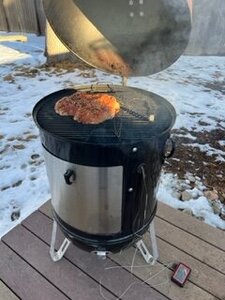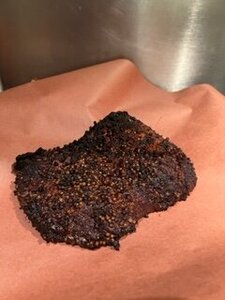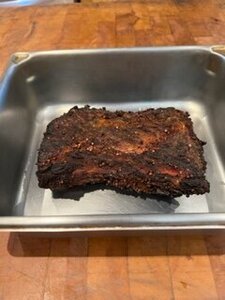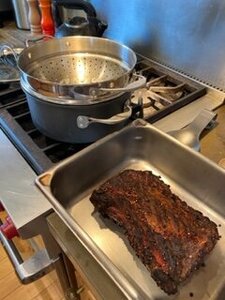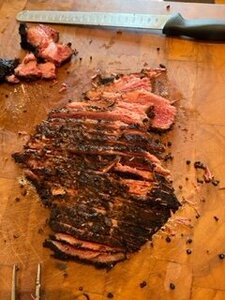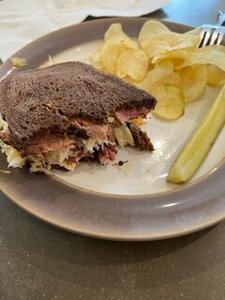Pastrami is smoked corned beef. The dominate flavor profile of the rub is pepper, garlic, and coriander.I want to do a pastrami next. Isn't pastrami just thin-cut corned beef? Or is it a different spice and brine recipe or cut of meat?
Brisket - Corned beef and Pastrami
- Thread starter MileHiGuy
- Start date
-
Some of the links on this forum allow SMF, at no cost to you, to earn a small commission when you click through and make a purchase. Let me know if you have any questions about this.
You are using an out of date browser. It may not display this or other websites correctly.
You should upgrade or use an alternative browser.
You should upgrade or use an alternative browser.
SmokingMeatForums.com is reader supported and as an Amazon Associate, we may earn commissions from qualifying purchases.
Here is the recipe / process I am following, it's a take-off from a recipe I found on the Amazing Ribs website - from Meathead Goldwyn:
I did modify the recipes I have to accommodate a whole packer brisket. The recipe below is after my modifications.
Pickling Spice:
3 T prague powder #1
4 T whole mustard seeds
3 T whole allspice berries
2 T ground coriander (the recipe calls for whole coriander seeds but I didn't have any)
1 T ground Ginger
1 T red pepper flakes
4 T ground cinnamon
6 Bay leaves
15 whole cloves
2 cups of brown sugar
10 cloves of garlic
4 gallons of water
14.3 lb packer brisket (I bought it at Costco, it's choice beef. I've used Prime beef before but couldn't tell the difference.)
equipment: large plastic Cambro to let the brined meat sit in for a week
Combine all the dry ingredients and garlic, add the water to the Cambro, add the dry ingredients (oh and don't forget to drink beer while doing this), stir the brine well.
Trim the brisket and separate the point from the flat. I cut the flat in half to make 3 cuts of meat. I intend to use one of the less fatty cuts for Corned beef and the other two for pastrami. Place the meat in the brine and let it sit for at least a week to make corned beef brisket. Stir each day to move the meat around and let it absorb the brine.
That is as far as I am right now. I will add more later.
So I have a 15lb I want to do the flat parts Corned beef and point probably pastrami
If you use meatheads calculator, it says to use 7 tsp of #1 for 15lbs of meat???
Or did you stick with the 3 tsp method because you were cut into smaller chunks??
It also calls for Kosher Salt... did you use any???
Well, in addition to the 15# of meat, there is water in the bucket. So you take the meat weight, plus the water weight for a total weight. Cure #1 is based on 0.25% of the total weight. When dry curing, Cure #1 is based on 0.25% of the meat weight.If you use meatheads calculator, it says to use 7 tsp of #1 for 15lbs of meat???
Pickling Spice:
3 T prague powder #1
4 T whole mustard seeds
3 T whole allspice berries
2 T ground coriander (the recipe calls for whole coriander seeds but I didn't have any)
1 T ground Ginger
1 T red pepper flakes
4 T ground cinnamon
Table spoons right??
Upper case T usually indicates tablespoon. Never hurts to ask thoughTable spoons right??
Upper case T usually indicates tablespoon. Never hurts to ask though
Well, that's noted but just checking since it involves something like #1
THNX
yes, sorry just saw this.Table spoons right??
T = tablespoon
t = teaspoon
I did not add any additional Kosher salt. I have used salt with Prague Powder in the past but did not for this one.So I have a 15lb I want to do the flat parts Corned beef and point probably pastrami
If you use meatheads calculator, it says to use 7 tsp of #1 for 15lbs of meat???
Or did you stick with the 3 tsp method because you were cut into smaller chunks??
It also calls for Kosher Salt... did you use any???
View attachment 526037
I did smoke the point section of the brisket and make Pastrami...I love Pastrami! After I smoked it - to around 180 degrees I believe, I wrapped it in butcher paper overnight in the refrigerator and then steamed it on the stove cooktop in a steamer basket the next day. It was great! I sliced it up and made sandwiches with it.
Attachments
I had the 3rd section of the brisket that I brined which I froze. It was corned beef. I thawed it out a couple weeks after freezing it and baked it and used it for corned beef sandwiches. This section I made traditional Reuben sandwiches with. It was great.
Attachments
Just for conversation.... Prague powder #1 is another name for Cure #1, Instacure #1, Quickcure #1, Pink salt and a few others. All these products use salt as a carrier for the sodium nitrite which is suspended by a special process so it's won't settle out. It's not a substitute for salt.I did not add any additional Kosher salt. I have used salt with Prague Powder in the past but did not for this one.
Some sort of finishing method is not mandatory by any means but it makes the difference between very good pastrami and wonderful pastrami. Yours looks great by the way.After I smoked it - to around 180 degrees I believe, I wrapped it in butcher paper overnight in the refrigerator and then steamed it on the stove cooktop in a steamer basket the next day. It was great!
Thank you... just wanted to make sure... You have inspired me to go ahead with my 15# brisket as soon as I can.I did not add any additional Kosher salt. I have used salt with Prague Powder in the past but did not for this one.
Well, in addition to the 15# of meat, there is water in the bucket. So you take the meat weight, plus the water weight for a total weight. Cure #1 is based on 0.25% of the total weight. When dry curing, Cure #1 is based on 0.25% of the meat weight.
Hey thirdeye! I'm new and confused. Can you help me out?
I've done a handful of cures always with Pop's brine. He says that you can essentially whip up a 55-gallon drum of his stuff, drop a chicken into it, and it will cure. Safely.
Now, I'm reading here and a lot of other places about measuring carefully and taking into account water weight. I'm not getting it.
No slight against you, thirdeye. I've read instructions like yours all over the place. Even online calculators have it. But... why not just whip up a quick brine, cure everything with it, and be done with it? Am I missing something?
Thank you and everyone in advance,
Murph
Last edited:
Hey thirdeye! I'm new and confused. Can you help me out?
I've done a handful of cures always with Pop's brine. He says that you can essentially whip up a 55-gallon drum of his stuff, drop a chicken into it, and it will cure. Safely.
Now, I'm reading here and a lot of other places about measuring carefully and taking into account water weight. I'm not getting it.
There are rules and then exceptions. In the world of curing, which has roots hundreds and hundreds of years old, early methods were not approved by some governing body like they are today. The methods were proved and demonstrated to be reliable over time. So let's call those methods tried and true methods.
Pop's Father developed this 'real simple curing brine' and it was a tried and true method. But he took it one step further since this method was used in the family's store and custom meat market in New York state. Pop's Brine and the method were reviewed by the State of NY inspectors and approved for use. It is a lower strength brine and needs slightly longer brining times. However this improves flavor and texture in some meats.
I put this method under the heading of a 'universal curing method', much like the salt box dry curing method my Grandfather used. It does not exactly follow modern guidelines..... but it works.
So back to your question..... Pop's Brine uses a fixed amount of Cure #1 and allows for some personal adjustment of salt, sugar and any other aromatics. There are several versions of Pop's Brine as he and others experimented with salt and sugar, but the ratio of Cure #1 to water remained the same What is interesting is that it's generally recognized in curing circles that the safe amount of Cure #1 used in one gallon of water is between 1 tablespoon and 3.5 tablespoons. You can run hypothetical calculations and the result falls into the acceptable range.
In my eyes, the beauty of Pop's Brine is 1) It's proven to be reliable, and 2) It's easy to mix, and 3) I like using lower salt concentration brines (whether they are a flavor brine, a curing brine, or a corning brine) and longer brining times.
All that said, I make personal adjustments to Pop's Brine too. I'm on the lower end of his recommended amounts of salt and sugar, and I prefer white sugar to brown sugar.
~thirdeye~ version of Pop's Brine
This version is a low salt and less sweet mixture. I generally use it on chicken breasts or pork chops with a 15 to 24 hour brine time.
1 gallon of water
125 grams canning salt
25 grams white sugar
25 grams brown sugar
20 grams Cure #1 (heaping tablespoon)
3/4 teaspoon black pepper
Good Information!!!There are rules and then exceptions. In the world of curing, which has roots hundreds and hundreds of years old, early methods were not approved by some governing body like they are today. The methods were proved and demonstrated to be reliable over time. So let's call those methods tried and true methods.
Pop's Father developed this 'real simple curing brine' and it was a tried and true method. But he took it one step further since this method was used in the family's store and custom meat market in New York state. Pop's Brine and the method were reviewed by the State of NY inspectors and approved for use. It is a lower strength brine and needs slightly longer brining times. However this improves flavor and texture in some meats.
I put this method under the heading of a 'universal curing method', much like the salt box dry curing method my Grandfather used. It does not exactly follow modern guidelines..... but it works.
So back to your question..... Pop's Brine uses a fixed amount of Cure #1 and allows for some personal adjustment of salt, sugar and any other aromatics. There are several versions of Pop's Brine as he and others experimented with salt and sugar, but the ratio of Cure #1 to water remained the same What is interesting is that it's generally recognized in curing circles that the safe amount of Cure #1 used in one gallon of water is between 1 tablespoon and 3.5 tablespoons. You can run hypothetical calculations and the result falls into the acceptable range.
In my eyes, the beauty of Pop's Brine is 1) It's proven to be reliable, and 2) It's easy to mix, and 3) I like using lower salt concentration brines (whether they are a flavor brine, a curing brine, or a corning brine) and longer brining times.
All that said, I make personal adjustments to Pop's Brine too. I'm on the lower end of his recommended amounts of salt and sugar, and I prefer white sugar to brown sugar.
~thirdeye~ version of Pop's Brine
This version is a low salt and less sweet mixture. I generally use it on chicken breasts or pork chops with a 15 to 24 hour brine time.
1 gallon of water
125 grams canning salt
25 grams white sugar
25 grams brown sugar
20 grams Cure #1 (heaping tablespoon)
3/4 teaspoon black pepper
This is called equilibrium brine. We do this so that the meat product is neither over or under salty and not over under on nitrite.Now, I'm reading here and a lot of other places about measuring carefully and taking into account water weight. I'm not getting it.
Traditional brining was done to cure and preserve meat but also took into consideration spoilage from the lack of refrigeration or controlled temperature. So brine recipes are traditionally high in salt to combat bacteria and to speed the process up. The higher the salt concentration the faster the cure, however this becomes a balancing act as far as when to pull the meat. Leave it too long and it’s over salty, not long enough and it’s not cured. Over the years this has been resolved with refrigeration and the ability to lower the salt concentration. Pop’s brine is an example of this. He used lower salt and a longer cure time to tenderize the meats and so the wife didn’t have to pre soak or boil the meat to reduce the salt. Flavor. Pop’s brine process is now taken to the next level with refrigeration and equilibrium brining where weigh the water and meat and apply the percentage of salt and cure we ultimately want in the finished product. In this way we need to be in brine long enough, but if we go over time even another week, because life got in the way, the finished product is still exactly the salt level we wanted. It’s controlled brining. This gives you flexibility on time.
For reference, a traditional brine would be a salt concentration of 60* SAL (using a salineOMeter) that’s a salt concentration of almost 16%, in contrast the recipe that
Funny you mentioned degree brining.... As an example, I almost mentioned how a 80° fish brine might only take 30 or 45 minutes in contrast to lower strength brines. That's a tight window. For what it's worth Meat & Sausages doesn't even recognize degree brines <20° saying they are too weak. But we know differently. Maybe too weak for commercial or practical brine times? Anyways, I haven't broken out my brine tester in years since we've evolved away from that method.For reference, a traditional brine would be a salt concentration of 60* SAL (using a salineOMeter) that’s a salt concentration of almost 16%, in contrast the recipe thatthirdeye
thirdeye posted would have a 10* SAL or roughly 2.7% salt. However if I wanted a finished salt of 1.75% I can mix this accordingly but understanding that the process will take longer To reach equilibrium.
There are rules and then exceptions. In the world of curing, which has roots hundreds and hundreds of years old, early methods were not approved by some governing body like they are today. The methods were proved and demonstrated to be reliable over time. So let's call those methods tried and true methods.
Pop's Father developed this 'real simple curing brine' and it was a tried and true method. But he took it one step further since this method was used in the family's store and custom meat market in New York state. Pop's Brine and the method were reviewed by the State of NY inspectors and approved for use. It is a lower strength brine and needs slightly longer brining times. However this improves flavor and texture in some meats.
I put this method under the heading of a 'universal curing method', much like the salt box dry curing method my Grandfather used. It does not exactly follow modern guidelines..... but it works.
So back to your question..... Pop's Brine uses a fixed amount of Cure #1 and allows for some personal adjustment of salt, sugar and any other aromatics. There are several versions of Pop's Brine as he and others experimented with salt and sugar, but the ratio of Cure #1 to water remained the same What is interesting is that it's generally recognized in curing circles that the safe amount of Cure #1 used in one gallon of water is between 1 tablespoon and 3.5 tablespoons. You can run hypothetical calculations and the result falls into the acceptable range.
In my eyes, the beauty of Pop's Brine is 1) It's proven to be reliable, and 2) It's easy to mix, and 3) I like using lower salt concentration brines (whether they are a flavor brine, a curing brine, or a corning brine) and longer brining times.
All that said, I make personal adjustments to Pop's Brine too. I'm on the lower end of his recommended amounts of salt and sugar, and I prefer white sugar to brown sugar.
~thirdeye~ version of Pop's Brine
This version is a low salt and less sweet mixture. I generally use it on chicken breasts or pork chops with a 15 to 24 hour brine time.
1 gallon of water
125 grams canning salt
25 grams white sugar
25 grams brown sugar
20 grams Cure #1 (heaping tablespoon)
3/4 teaspoon black pepper
Wow! Thirdeye, thank you very much for your thoughtful and thorough reply! That is really nice of you.
I'm with you... I modify Pop's brine to suit what I'm after but stick with the water/cure ratio he gives.
Before I came to SMF, I was going through a site by a man nicknamed Meathead. He really kind of scared the daylights out of me with his precision. It seemed so complicated until I came here.
Thanks again!
Murph
Curing is a simple and also a complicated art. Depends how deep you want to go.It seemed so complicated until I came here.
SmokingMeatForums.com is reader supported and as an Amazon Associate, we may earn commissions from qualifying purchases.
Similar threads
- Replies
- 9
- Views
- 9K
Latest posts
-
-
-
It's all fun and games until your kid decides she's coming for your crown.
- Latest: MileHighSmokerGirl
-
-
Featured Christmas Tomahawks! (With Smoked Ham & Smoked Cream Cheese)
- Latest: MileHighSmokerGirl
Hot Threads
-
Featured Christmas Eve Lasagna , salad and sourdough
- Started by chopsaw
- Replies: 35
- General Discussion
-
Damn dishwasher....
- Started by Steve H
- Replies: 27
- Blowing Smoke Around the Smoker.
-
Featured Merry Christmas
- Started by pineywoods
- Replies: 26
- Blowing Smoke Around the Smoker.
-
Is my bacon bad? Please help
- Started by hooked on smoke
- Replies: 25
- Bacon
-
Boneless ham ideas.
- Started by Steve H
- Replies: 25
- General Discussion


